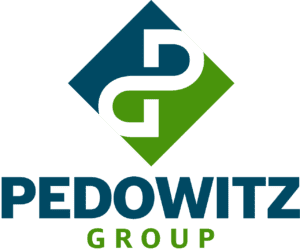In the 1960s, NASA had a room full of mathematicians whose sole job was crunching equations to calculate and then recalculate data to determine a trajectory for a space launch. They were known as “computers.” Running all the necessary numbers would take the team upward of three months, as well as specialized skills and advanced knowledge.
Today, running that same set of numbers takes a modern computer a few minutes. With the exponential increase in the ability to handle and process information, NASA can do more sophisticated work with higher accuracy and put their talent to work on much more significant challenges.

In marketing, we’re able to do the same thing. We have volumes of data on our customers and their behavior made comprehensible by algorithms and computing.
But setting up systems to drive marketing efficiency, collecting data on what’s working and what’s next, and constantly using that insight to increase effectiveness is the task of a very elite team.
They are the rocket scientists of your organization.
They are marketing operations: a crucial part of revenue operations, but a team unto itself that’s well worth thinking through.
Are you ready?
To answer this, let’s discuss the elements you need to produce a world-class marketing operations team. With this team in place, your marketing function will evolve into a revenue-generating center of excellence. I first published a whitepaper on this in 2018, and you can regard this as an update on those thoughts (with much more added in!).
Goodbye to being seen as a cost center or a department that’s always secondary to others … hello revenue!
To fully realize the value of Marketing Operations, let’s dive deep … click to jump to a particular section!
- Understand the Definition of Marketing Operations (and the three areas they really impact)
- What Stage Are You? The Marketing Operations Maturity Model
- Know (And Communicate) Its Value To Key Stakeholders
- Develop Team Structure
- Identify Key Roles and Find Talent
- Establish Team Goals and Strategy
Buckle up, or maybe block some time on your calendar. We’re about to dive in and examine this from all angles.
Get more: Think through your team(s) with this ungated talent bundle or grab this ungated marketing operations bundle to apply what you’ll learn from this article
What A Strategic Marketing Operations (MOPs) Function Is
At the highest level, MOPs teams work across functions within and outside marketing to focus relentlessly on improving marketing efforts. They are simultaneously tamers of complexity and infusers of sophistication who transform not just marketing departments but entire organizations.
At its core, marketing operations is a team of people skilled in marketing technology; Software as a Service (SaaS); data management; vendor management; process innovation and optimization; and metrics, reporting, and analysis. They provide the infrastructure, processes, and reporting that power revenue marketing.
Frequently, this group also manages the training and education services for marketing. It must be an expert in technical execution and enforcement of best practices governance, ensuring a cohesive customer experience of the brand through all outbound and inbound campaigns.
This definition can seem broad because, well … it is!
We’ve seen roles and responsibilities vary widely from company to company who have invested in a marketing operations function. The most significant factor in this variation is a company’s Revenue Marketing maturity.
What’s Driven This Need
If you’ve been near marketing, you’ve seen the technologies available explode (cue the obligatory Scott Brinker supergraphic reference, right?).
Nearly overnight, conferences focused solely on MarTech sprung up and have become must-see events. The job market exploded, and top talent was already poached pre-COVID.
Add in a shift towards greater financial accountability, tremendous pressure on companies to transform into providing more customer-centric experiences, and battling legacy thinking and processes that marketing is the “make it pretty” department, and you have a clear need for any company looking to lead.
In addition, B2B customers now require a B2C experience – after all, B2B buyers are B2C somewhere else! Our experiences as consumers across the digital landscape drive our expectations, forcing many companies to rethink how they engage customers and embrace that totally overused-but-still-valid term … digital transformation.
Facing a Talent crunch?
So is nearly everyone who needs marketing ops help!
Go ahead and get everything in our (ungated!) talent bundle. Click that link and get help thinking through hiring, job descriptions, org charts, interviews, and more.
And if you have a talent gap, an option to consider is outsourcing. You avoid going through HR’s hiring processes and battling for budget, get a practicing expert to function on your team, and have reduced risk with a full-time outsourced role vs. hiring a headcount.
With a couple of solutions in-hand, let’s talk more about your current state:
Think about your current marketing department.
Who, within it, is most likely to be able to answer these questions:
- What kind of data do we have, and what does it mean?
- What was the most effective money we spent this year?
- How do we invest more that way?
Many executives struggle to identify someone who can answer one of these questions, let alone all three.
Typically, the answers are held across different people on different teams. And the problem is that those people need to come together with their pieces to see the big picture.

Marketing operations is like a special forces team.
It’s an elite cadre of people charged with looking at all efforts and making them more efficient and effective. MOPs is a centralized function, the source of data and insights for leadership decision-making, and the basis for marketing productivity, agility, and accountability.
They cross all roles, uniting the work of marketing.
Within the charter of a MOPs team, we’d expect to see three areas of intense focus:
- Enabling digital transformation
- Adopting business accountability by driving revenue and growth
- Leading customer centricity.
These three areas are essential for MOPs because they are transcendent. Not only do they cross many areas, but they also bleed out of marketing into other units. This cross-functional nature makes digital transformation, business accountability, and customer centricity harder to tackle.
But it’s worth it because these three areas also make the most significant impact.
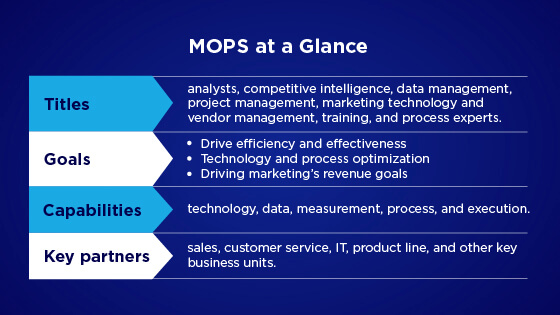
Enabling Digital Transformation
Marketing operations’ most important role is strategically stewarding data; typically, that also means technology. While technology tends to be the first concept organizations think about for digital transformation, it’s not the only hallmark to examine for successful change.
We’re looking for a MOPs team to engrain marketing technology into the enterprise and use insights to drive revenue. More work is made possible by moving connections deeper into the organization, and more data is captured. Then, the data gets mined for applied insights and pays off in increased revenue. And over a relatively short period, the technologies become ingrained.
It’s a lot like the shift that happened when we stopped doing complex math by hand and turned the tasks over to computers. In the 1960s, it would take a team of people three months to calculate a launch trajectory for a NASA space flight. Today that work takes a few minutes or less.
Most organizations can access volumes of information, but it takes leadership from MOPs to make sense of it and find transformative insights within the data.
It sounds obvious, but you begin to understand the complexity when you try to pull it off. A favorite example of this at the moment is intent data. We can get more insight than ever about what prospects are likely to do. But it has two big strings attached:
- Getting this data requires specific expertise, and it’s expensive to attain.
- Once you have it, you need to know what to do with it.
A strategic marketing operations team tackles these problems. When the unit is deeply ingrained in your organization, they dig deep for data. They integrate it with platforms to amplify insights with other data in other systems and strategically work with vendors on the outside to curate a stunning array of insights. From there, it’s all about action.
Like a great connector, MOPs gives insights to the right teams – often sales – who can act on it and turn it into conversion points to drive revenue.
Related: Key questions to ask about your tech stack
Business Accountability To Drive Growth
Marketing organizations traditionally have to fight for budget, especially if you have not transformed into a revenue marketing organization.
That’s because when you and your executive team hand money off to marketing, it can sometimes be an act of faith. You know the money makes an impact…somehow. But you’ve got little more than logo-emblazoned swag to show results for the investment.

Marketing operations should include an element of financial accountability, so that every dollar invested in marketing has a forecasted return. Year over year, budgets are geared to the activities that build revenue, and your ability to see what those activities are is how you build your case for budget and growth.
Over time there’s an ironclad, undeniable benefit to this approach: marketing’s value is demonstrated in finite detail.
- Business case: fortified.
- Investments: returned.
- Future requests: granted.
- Your role in revenue: undeniable!
Leading Customer Centricity
Marketing operations put one question at the heart of every activity: “how does this serve our customer(s)?”
This question supports two key elements: a customer profile/buyer persona and a customer journey. And the answer is a blend of art and science.
Buyer personas clearly describe what levers you must pull to engage your customer.
The customer journey describes the sequence of pulling the levers to lead to a sale. It helps you identify which behaviors or data points indicate a prospect isn’t right to buy, so you stop directing effort at converting them.
Answering the call to put the customer at the heart of all activities is partially in the realm of a tech geek to mine data and technology. And it’s a yet-to-be-recognized art form in that it takes much creativity to orchestrate a process that humanizes data and gives it a personalized element that engages your prospect.
Much like directors move us with stunning films, painters inspire us with beautiful colors, and musicians stir us with incredible music … marketing needs to create and connect with customers.
Related: What about revenue operations?
The Marketing Operations Maturity Model
Now that we have a broad definition, let’s figure out where your team might fall in maturity. Over 15+ years, we’ve seen a gradual evolution in marketing operations teams. While you may not have a formal team, pay attention to the markers of each maturity stage – you may be surprised at what capabilities your organization already possesses!
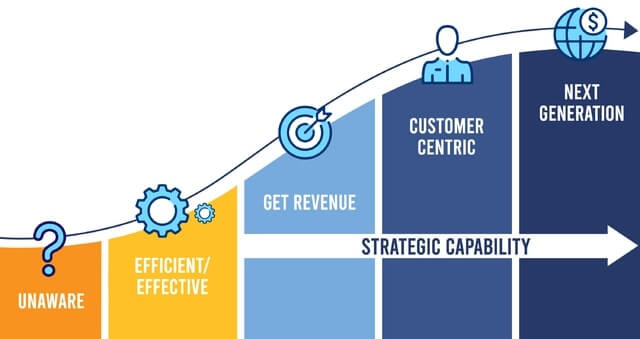
Stage 1: Unaware
I call this the “OMG” stage. Disparate groups perform uncoordinated tasks with no central vision or leadership – effectively, the entire marketing organization is siloed.
Company go-to-market strategies might be centered on products rather than customers. The tech stack is relatively basic, but gathered data doesn’t lead to action.
These days, you will find few companies that fall into this stage, but in the mid-2010s, it was far more rampant.
Stage 2: Efficient / Effective
In this stage, there’s an acknowledgment of the need to develop marketing operations, but not necessarily the commitment or budget. Typically, a team member dedicates most of their time to optimizing various tech investments, but they’re often on their own.
Some best practices might emerge, foundational reporting is created, and a standard operating procedure for selecting, implementing, and integrating systems/tech is in place.
The perceived value of this group revolves around automating previously-manual processes with technology, providing clean data, and insights into metrics.
Stage 3: Get Revenue
Doing the right things characterizes this stage. The MO function is imperative to driving marketing as an economic engine that’s both efficient and effective.
A formal budget is in place to support its function, with a dedicated leader who’s strategic and tying efforts to financial outcomes and key business objectives.
The tech stack is sophisticated, with the team feeling it is just a little behind (if at all) the general marketing curve, and there’s a forward-thinking roadmap.
However, the team is still functionally a silo. They primarily focus on marketing needs, which creates problems with other parts of the business.
Stage 4: Customer Centric
Now, the team is instrumental in operationalizing marketing accountability and driving transformational business activities. It’s a source of data and insights that allow marketing to forecast its impact on revenue + drive customer insights, and even lead those conversations on what the customer wants.
The MarTech stack is fully-integrated and optimized, and each tech has an answer to the question of “how does this serve the customer?”
But even still, there’s more to be gained.
Stage 5: Next Generation
a.k.a. the “one customer line of sight across the business” stage.
Marketing operations works with other teams, such as customer operations, and reports to the same leader. The trend towards revenue operations highlights this evolution, where sales, marketing, and even customer service roll up to the same leader, who’s often in the C-suite.
There’s an equal focus (and investment) on customer acquisition and customer expansion. Multiple teams lean on the same view across any part of the tech stack for a holistic view of the customer. Responses can be nearly in real-time to changing customer demands due to reliable, trusted data.
At this stage, the marketing operations team is likely part of a high-functioning RevOps model, but that’s not always the case.
The True Value(s) of Marketing Operations
If you want to jump to a particular section, here’s how MOPs brings value to the CMO, CFO, Sales, and Other Executives.
The Value To The CMO
A fundamental flaw in typical CMO thinking has a big impact on performance. As they try to lead the charge to transform marketing from a cost center to a revenue center, they have been trying to make this change by applying right-brained thinking to a left-brained problem.

This is probably why few CMOs report any long-term financial metrics. The moment technology invaded our world as consumers, and as marketers, the need for left-brained thinking became apparent. Yet, for many CMOs, their first foray into the technical and revenue accountability world was implemented with a different mindset and skill set.
The lucky CMO now has a second chance. The strategic marketing operations team can provide the required left-brained competencies and the mindset and skill set for technology, marketing, and business acumen. Some people call these left-brained marketers (LBMs) marketing technologists; others call them data scientists.
The LBM combines general marketing skills, business acumen, and deep technical and data analysis skills. Working in a marketing operations structure, the LBM is dedicated to technology (integration and optimization), data (understanding and producing shareable and consumable insights), and process optimization.
Companies with highly functional MOPs teams also demonstrate more revenue contribution than those without. The melding of technology, data, marketing, and analytics allows the CMO to understand how marketing efforts impact the pipeline and closed business. Any CMO who can produce credible revenue numbers and also forecast marketing’s impact on revenue is supported by a highly effective MO team.
Because of the group’s focus on data collection and analysis, the CMO has access to all the numbers to run marketing like a business. This kind of CMO runs a profit-and-loss statement and evaluates every expenditure to ensure the highest return. They also use data to figure out where and how to apply limited resources to optimize marketing ROI.
Without a highly-functional MOPs team, none of these business processes would be possible.
Once the CMO begins to produce credible revenue and growth, marketing gains credibility with the entire executive team. The CMO is perceived to be an equal and becomes more actively involved in the formation of company-wide strategies.
The Chief Marketing Officer has gained a voice and a seat at the table.
The Value To The CFO
- More business predictability
- More control
Historically, the CFO would rather stand in a cold shower tearing up $100 bills than sit down and talk about marketing budgets; at least they are sure they know where that money is going. The rise of the marketing operations team is making the CFO do the happy dance as they enjoy, for the first time, transparency in the marketing P&L statement.
As the MOPs function continues to mature, it enables tangible and credible marketing results as measured in pipeline and revenue. Not only can marketers describe past performance, but they can also now forecast future performance. This transparency and data-driven process allow the CMO to understand and work with marketing numbers to better impact company performance.
Finally, the CMO has more control over a huge budget and can weigh the outcomes.

The Value To Sales
- More revenue and quota attainment
- More competitive sales team
It’s no secret that marketing and sales have a checkered past. For too long, each group lived and worked separately with no reason to work together. Once marketing began to embrace marketing automation tools, and customers started becoming digital, marketing began engaging with sales. Unfortunately, this engagement often yielded poor results. Reasons included marketing not understanding sales and sales not understanding the new digital possibilities.
One stimulating effect of a strategic MOPs team is how they create highly beneficial and synergistic relationships with sales. It goes back to the right-brain versus left-brain approach. Salespeople are very black-and-white and driven by one primary metric: quota. The sales team is the ultimate winner when the MOPs team uses data to analyze current processes and then uses technology to implement those improvements.
The sales team can be more competitive and win more deals by providing real-time customer information to sales. Sales productivity improves, and quota attainment also enhances. All of this is possible in partnership with a strategic marketing operations group.
Related: Optimize your pipeline. Drive needed alignment. All with our lead management consulting services.
The Value To Other Executives
- A new tool for driving company growth
- A way to respond to the digital economy and the customer
The rise of marketing operations is crucial in enlightening the executive team on the possibilities of using marketing as a new revenue and growth tool. As marketing operations embrace technology, data, and analysis to achieve business objectives, marketing becomes a driver of revenue and company growth.
Executives are consumed with how to do business in the digital economy and with a customer who is now in firm control. Technology has changed both our personal lives and our professional practices to the extent that what worked in the past for executives only works in this engagement economy.
The MOPs team is sitting on top of a world of customer data that can be mined and analyzed to produce key customer insights
for better decision-making. No executive likes to make critical business decisions without data, and while gut instinct may work in some cases, given the speed of business today, real-time data is needed. This is the ultimate role of the MOPs team, and they may have the most significant impact on the future of the business.
Selling Its Value
As you work to build out an effective and strategic MOPs team, you will need to enlighten many key stakeholders.

The strategic MOPs team works across disciplines, and getting other groups’ buy-in and nurturing relationships is critical. Take the time to examine who needs to be a part of your empire-building and then be ready to educate them.
Your stakeholders are willing to partner if you can be clear about what’s in it for them. Use the information here and from other sources to build your case
The strategic marketing operations team creates benefits in many ways and across many parts of your organization.
Your Marketing Operations Structure
Marketing Charter
Before we dive into structure, let’s talk about intent. As a leader in your marketing organization, you need to set the intent of this Rockstar team. Establish a charter and your structure will follow.
Here are a few examples of charter statements we’ve seen over the years:
“To take a holistic and single-threaded approach to optimize technology, process and data across the entire customer life cycle to drive revenue and growth.”
Alex Simoes, RevOps Pioneer
- “Optimize marketing effectiveness with leading-edge technology, optimized process, clean and current data, and rigorous analysis.”
- “With digital transformation as the foundation, to build a unified operational capability that improves revenue performance through one line of sight to the customer.”
“Our charter is to enable the marketing team to achieve our overall goals. And our goals are—all around—creating pipeline and delivering on our revenue contribution.”
Kira Mondrus-Moyal, Senior Vice President of Global Marketing, Tricentis
Can we talk about org structure now? I need to start hiring!
With your charter articulated, you can now begin to focus on structure. Your first goal is to centralize the management of technology, process, data and marketing analytics to make your revenue generation efforts more efficient, effective, transparent and accountable.
To do this, you’ll need to collect a number of responsibilities in this unit. Typically, many of these already exist across your organization:
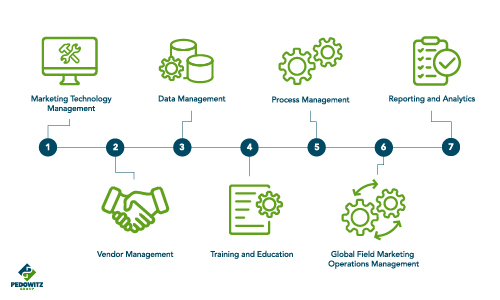
- MarTech strategy, selection, integration and optimization
- Vendor management
- Data management, governance and optimization
- Process engineering and optimization
- Measurement, analytics and reporting
- Project management, training and education
- Change management
- Campaign execution and content operations
All MO groups are a function of the unique needs of their company. We see many configurations, and there is no right or wrong. What is important is to be intentional in the structure and to ensure the structure meets marketing’s strategic demands to achieve the company’s measurable growth objectives.
Below is the most basic of organizational charts commonly-seen in a stage two marketing operation:

Related: Read how to build a modern marketing team for success
Identify Key Roles and Find Talent
Okay, you made it. Let’s talk about roles and talent. At its very core, your marketing operations team needs the following roles:
Director OR VP of Marketing Operations. Find a change-loving marketing “ninja” who is comfortable with technology, building consensus, and has a business and process mindset. It’s important to be at home with revenue accountability, finance, and reporting as well as the creative pursuits that marketing is more typically known for.
Finding someone with this balance is generally very difficult!
Reporting to the VP of MO are key functions led by:
- Director of Marketing Operations
- Marketing Automation Manager
- VP of Analytics
- Senior Analyst, Marketing Collaboration
Completing The Team
Completing your team is the next challenge, and this is your hiring priority list:
- Technologist: someone who can set the direction, lead governance and integration initiatives. They also take on vendor management.
- Data whiz: this could be a data scientist, or someone well versed in reporting and analytics.
- Process Engineer: Outsource this to someone high level who can step in and lead change through the transition.
- Trainer: Another role right for outsourcing, since the skills span different systems and your vendor support is the best bet for quality instruction.
- Project manager: borrow a good project manager from your IT function until the team has need for a full-timer.
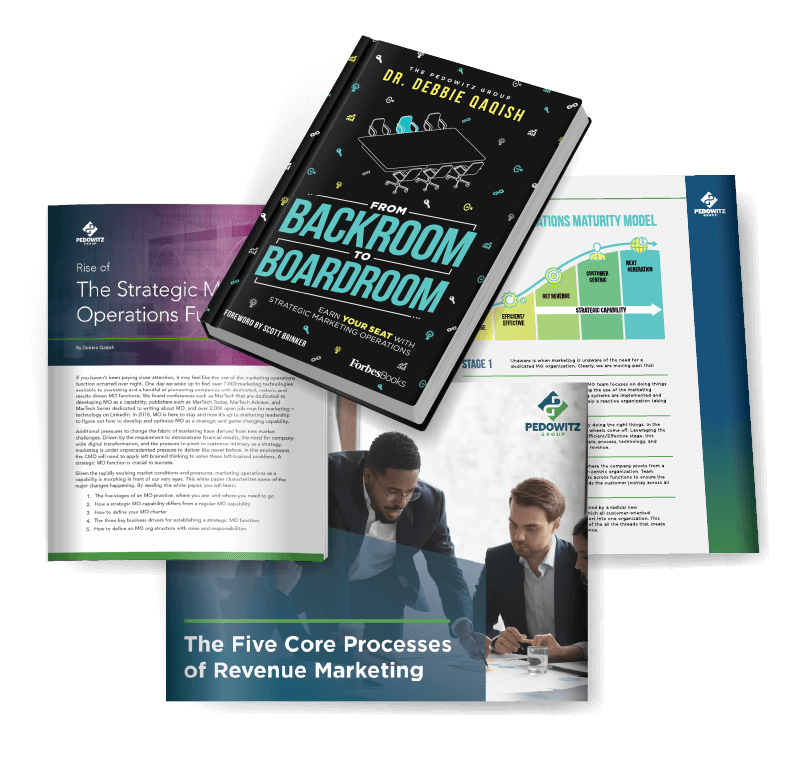
THE RISE OF THE REVENUE ANALYST
I’ve rarely seen this role on a marketing operations team. It seems to fall on the VP or CMO to figure this out (on top of everything else they’re responsible for).
My premise is that if a marketing ops team had a dedicated revenue analyst, marketing would overachieve their number. Let’s look at two key elements for this proposed role:
Sales background
The focus of the revenue analyst is to optimize not just marketing performance in general, but a specific number. That number might be the contribution to the pipeline or closed business in terms of percentage and dollars.
It would not be a number of MQLs. With this focus, I suggest this role needs a sales background and needs to be intimate with how a sales funnel works.
Deep knowledge of customer lifecycle
Next, the revenue analyst needs to be an opportunity spotter.
Translation: she uses data to continuously examine the entire customer lifecycle from acquisition to expansion to advocacy (think an infinity loop) and determines the best opportunities where marketing can invest and get the greatest return.
With a deep analytical acumen that is passionately applied to spot the best ROI opportunities, the revenue analyst is poised to optimize MarTech for its ultimate purpose – making marketing accountable for revenue.
Clearly, marketing has other responsibilities such as customer engagement. My argument is that the revenue analyst can only drive optimal revenue results based on a deep understanding of the customer.
In this sense, the revenue analyst role is a potential two-for-one win.
Finding Talent
As frustrating as talent acquisition may be, there are only a few ways to approach it. There are no shortcuts, and there are really four main strategies to get your team up and running as fast as possible:
- Rent the talent and hit the ground running.
- Hire outside experience and hit the ground running.
- Transfer talent from within and develop.
- Hire young professionals and develop.
The Need To Be More
Marketing operations is a capability. If someone leaves the organization, the capability does not. It is driven by strategy and operationalized through people, process, data and technology.
It delivers a business result.
This is why it is CRUCIAL to invest in knowledge management for your marketing operations team. Talent is hard to find and harder to keep. Without documentation to help with transitions, you’ll find yourself in a cycle of reboots without any tangible results!
Goals and Strategy
With a team in place or on the rise, it’s important to clearly set their direction. This becomes the most important role for leaders at the top of an organization.
We typically see the following five demands drive organizational change and the need for MOPs, so they are a good place to start with chartering your team.
- Increased need for marketing efficiency and organizational agility
- Changes to meet customer behavior, market conditions and business direction are too slow
- Revenue, margin, profit and market share need to improve.
- Marketing is not valued and seen as a cost center instead of a business, with formalized best practices, processes, infrastructure and reporting
- Data to make market, customer, and product/service decisions that create value for customers and shareholders must be better leveraged.
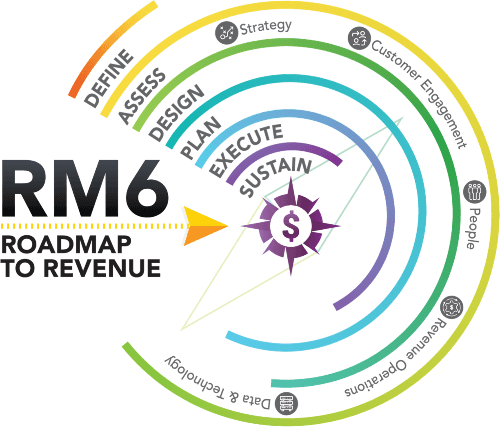
Addressing these questions means a focus on six key areas (which happen to align to the pillars of revenue marketing), each with questions to consider while setting goals.
Strategy
In the earliest days of a MOPs initiative, there’s some necessary navel gazing to understand where to start within your organization.
- How willing / ready is your company and leadership?
- Do sales and marketing work seamlessly together? Or is it a fractured relationship?
- Is your marketing team “in the know” on what product teams are doing, and is there a strong working relationship between teams with good, proactive communication?
People
This pertains to anyone in marketing, who’s aligned with marketing, and the organizational structure around marketing. Especially because members of this team are so hard to hire, part of this conversation might be
- What skills does your team need – and what needs to be done to get them (through new talent or training existing talent)?
- For every group that interacts with the customer (at any point!), who’s the stakeholder(s) in each you need to work with to build greater alignment?
- How can / should marketing lead your focus on customer experience?
Process
This is typically the first area that can be addressed, as marketing has more influence in this area.
- Are campaigns / programs well-oriented to what you see in the market? To what product managers, etc. see in the market?
- How confident are you in your data? What about as it flows between systems, such as a marketing automation platform and your CRM? Who controls what data is deemed “best” in your organization … and how does this impact you?
- Is your lead management process excellent? Or does marketing feel there is significant lead leakage in the pipeline?
- Who governs processes and enforces agreed-upon standards? (This is very important!)
Technology
If you don’t have the right technology, you cannot fully embrace a true customer-focused approach! In our Revenue Marketing Index, we found 82% of CMOs it’s important to be fluent in understanding tech from a strategic perspective to fully enhance demand generation efforts to better impact revenue.
- Does your current technology allow you to provide personal, targeted experiences for customers both now and two years from now?
- What does the marketing team own? This impacts your ability to lead in this area and may tie in with “people” above.
- Are you fully leveraging what your current tech is capable of? Do you know how to find out?
- Do you have regular meetings to review your tech stack and ensure it is updated, data is flowing, and processes are being enforced?
Related: Our technology consulting services optimize your current stack and save you money
Customer
This really gets to the heart of your customer journey from initial engagement to post-purchase nurturing.
Really, it gets to the core of the sales / marketing relationship and how well each works with the other on the entire customer lifecycle.
Who owns the customer? What about after they become a customer … how to you continue to invest in the relationship? What are their expectations?
For more on this topic, dive into updating your customer journey.
Results
None of your marketing matters with measurable impact – and none of the impact matters unless you can trace it to revenue for the business. Focusing on repeatable, scalable, and predictable processes and outcomes only strengthens this area.
- What is the one customer metric that equates to financial value?
This allows you to anchor reporting efforts around a central theme that will resonate with key stakeholders (and build more marketing credibility within your organization).
Get Started + Next Steps
Now that you understand how to realize its full value, it’s time to something about it! Here’s a few next steps:
- Dig into this (ungated) strategic bundle of documents to help you do even more.
- I’ve written a book on this very topic! From Backroom To Boardroom has so much more as a deep-dive into marketing operations and how it not just earns a seat at the revenue table, but also how to build on its success
And you can always look into our marketing operations consulting services if you want to drive key changes throughout your organization for revenue impact.
